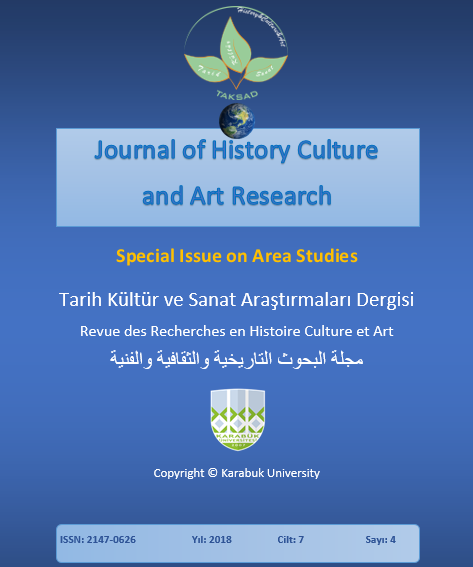Functioning of a Verbal Predicate in the Artistic Style of Yakut Language
DOI:
https://doi.org/10.7596/taksad.v7i4.1843Keywords:
Yakut language, Artistic style, Simple, Complex, Compound and complex verbal predicate, Stylo-statistical method, Semantic-stylistic method, Modal meanings, Syntax means.Abstract
In this article the verbal predicate functioning in the artistic style of the Yakut language is subjected to semantic-stylistic and stylo-statistical analysis. The authors consider artistic style’s rich language as one of the functional style varieties, which implies a comparative study of its language with the language of other styles of speech. As a result of analysis, the lexical-semantic and grammatical-semantic characteristics of verbal predicates are given as one of the main members of sentence that determine the symmetry of modal grammatical meanings specific to the artistic style. Also revealed quantitative indicators of verbal predicates of artistic style in close relationship with their qualitative characteristics.
The theoretical and methodological basis of the study depend works of L.N. Kharitonov, E.I. Korkina, P.S. Afanas’ev, P.A. Sleptsov, N.E. Petrov, G.G. Filippov and others on various aspects of the studied problem. A semantic-stylistic method, stylo-statistical and comparative methods are applied in the study. The study reveals the frequency of the verbal predicate forms use in the artistic style, which allowed to objectively assess the indicators that were identified using the semantic-stylistic method. The comparative method contributed to reveal the stylistic originality of the artistic style in relation to other styles.
The functioning of the verbal predicate in the artistic style depends on the grammatical semantics of some verb forms, as well as lexical-semantic nature of certain verbal predicates. Revealed the absolute superiority in quantitative terms of the analytical forms of the composite predicate expressed by the forms of the species, the past tense and mood. The stylistic power of composite predicate’s analytical forms lies in their semantic nature, which assumes the presence of all richness of diverse modal meanings of the syntactic means of the Yakut language.
References
Afanasiev, P. S. (1996). Modern Yakut language. Lexicology (in Yakut language): a tutorial. Yakutsk: Yakutsk state University.
Bondarko, A. V. (1971). Type and time of the Russian verb. Moscow: Prosveshchenie.
Danilov, S. P. (1996). Collected works. Volume II. While the heart beats. Yakutsk: Sakhapoligrafizdat.
Filippov, G. G. & Vinokurov, I. P. (1995). Yakut language. Vocabulary. Phonetics. Morphology. Yakutsk: Bichik.
Grigoriev, N. S. (1976). On the stylistic function of phraseological units in the Yakut language. Yakut philological collection. Yakutsk: Yakutsk branch of the Siberian branch of the Academy of Sciences of USSR, 72-82.
Kharitonov, L. N. (1947). Modern Yakut language. Phonetics and morphology. Part 1. Yakutsk: Yakutsk state printing house.
Kharitonov, L. N. (1954). Types of verbal basis in the Yakut language. Moscow-Leningrad: USSR Academy of Sciences.
Kharitonov, L. N. (1960). Forms of verbal form in the Yakut language. Moscow-Leningrad: USSR Academy of Sciences.
Kharitonov, L. N. & Ubriatova, E. I. and others (1982). Grammar of modern Yakut literary language. Vol.1. Phonetics and morphology. Moscow: Nauka.
Korkina, E. I. (1970). Mood of the verb in Yakut language. Moscow: Nauka, 1970.
Mordinov, N. E. & Achchygyia, A. (1994). Springtime. Yakutsk: Bichik.
Oyunsky, P. A. (1993). Compositions. In three volumes. Volume I, II. Yakutsk: Bichik.
Petrov, N. E. (1999). Syntactic means of expressing modality in the Yakut language. Novosibirsk: Nauka.
Petrova, T. I. (1996). Speak the pure language of Sakha (Yakut): Educational and methodical publication. Yakutsk: Ministry of education of the Republic of Sakha (Yakutia).
Petrova, T. I. (2002). The use of species forms (in the Yakut language). Expressive means of the Yakut language. (Special edition No. 7). Yakutsk: Yakutsk state University, 22-24.
Prokopovich, E. N. (1969). Stylistics of parts of speech (Verbal word forms). Moscow: Prosveshchenie.
Prokopovich, E. N. (1982). The verb in the sentence. Semantics and stylistics of species-time forms. Moscow: Nauka.
Sivtsev, D. K. & Omolloon, S. (1976). Dramas. Yakutsk: Yakutsk book publishing house.
Sleptsov, P. A. (1986). Yakut literary language. The origins, the emergence of norms. Part 1. Novosibirsk: Nauka.
Sleptsov, P. A. (1996). The study of language – major problem (in the Yakut language). Yakutsk: Yakutsk state University. M. K. Ammosov.
Smetanin, T. E. (1999). Works in two volumes. Poems, poems, stories, dramas. Volume II. Yakutsk: Bichik.
Stepanov, N. T. (1991). Descendants of N’yrbakan. Ancient legends. Yakutsk: Yakutian scientific center, USSR Academy of Sciences.
Yakut-Russian dictionary (1972). Moscow: Soviet encyclopedia.
Downloads
Published
How to Cite
Issue
Section
License
All papers licensed under Creative Commons 4.0 CC-BY.- Share — copy and redistribute the material in any medium or format
- Adapt — remix, transform, and build upon the material for any purpose, even commercially.
Under the following terms:
Attribution — You must give appropriate credit, provide a link to the license, and indicate if changes were made. You may do so in any reasonable manner, but not in any way that suggests the licensor endorses you or your use.
- No additional restrictions — You may not apply legal terms or technological measures that legally restrict others from doing anything the license permits.







